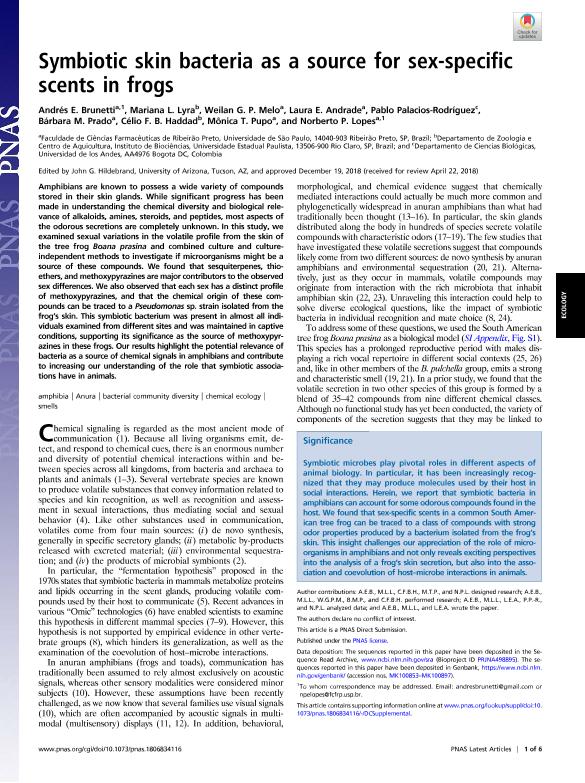Mostrar el registro sencillo del ítem
dc.contributor.author
Brunetti, Andrés Eduardo

dc.contributor.author
Lucio Lyra, Mariana

dc.contributor.author
Melo, Weilan G. P.
dc.contributor.author
Andrade, Laura Elena

dc.contributor.author
Palacios Rodríguez, Pablo
dc.contributor.author
Prado, Bárbara M.
dc.contributor.author
Baptista Haddad, Célio Fernando

dc.contributor.author
Tallarico Pupo, Monica

dc.contributor.author
Peporine Lopes, Norberto

dc.date.available
2020-07-20T06:52:33Z
dc.date.issued
2019-02
dc.identifier.citation
Brunetti, Andrés Eduardo; Lucio Lyra, Mariana; Melo, Weilan G. P.; Andrade, Laura Elena; Palacios Rodríguez, Pablo; et al.; Symbiotic skin bacteria as a source for sex-specific scents in frogs; National Academy of Sciences; Proceedings of the National Academy of Sciences of The United States of America; 116; 6; 2-2019; 2124-2129
dc.identifier.issn
0027-8424
dc.identifier.uri
http://hdl.handle.net/11336/109611
dc.description.abstract
Amphibians are known to possess a wide variety of compounds stored in their skin glands. While significant progress has been made in understanding the chemical diversity and biological relevance of alkaloids, amines, steroids, and peptides, most aspects of the odorous secretions are completely unknown. In this study, we examined sexual variations in the volatile profile from the skin of the tree frog Boana prasina and combined culture and culture-independent methods to investigate if microorganisms might be a source of these compounds. We found that sesquiterpenes, thioethers, and methoxypyrazines are major contributors to the observed sex differences. We also observed that each sex has a distinct profile of methoxypyrazines, and that the chemical origin of these compounds can be traced to a Pseudomonas sp. strain isolated from the frog´s skin. This symbiotic bacterium was present in almost all individuals examined from different sites and was maintained in captive conditions, supporting its significance as the source of methoxypyrazines in these frogs. Our results highlight the potential relevance of bacteria as a source of chemical signals in amphibians and contribute to increasing our understanding of the role that symbiotic associations have in animals.
dc.format
application/pdf
dc.language.iso
eng
dc.publisher
National Academy of Sciences

dc.rights
info:eu-repo/semantics/openAccess
dc.rights.uri
https://creativecommons.org/licenses/by-nc-nd/2.5/ar/
dc.subject
AMPHIBIA
dc.subject
ANURA
dc.subject
BACTERIAL COMMUNITY DIVERSITY
dc.subject
CHEMICAL ECOLOGY
dc.subject
SMELLS
dc.subject.classification
Biología Celular, Microbiología

dc.subject.classification
Ciencias Biológicas

dc.subject.classification
CIENCIAS NATURALES Y EXACTAS

dc.title
Symbiotic skin bacteria as a source for sex-specific scents in frogs
dc.type
info:eu-repo/semantics/article
dc.type
info:ar-repo/semantics/artículo
dc.type
info:eu-repo/semantics/publishedVersion
dc.date.updated
2020-06-30T13:51:13Z
dc.identifier.eissn
1091-6490
dc.journal.volume
116
dc.journal.number
6
dc.journal.pagination
2124-2129
dc.journal.pais
Estados Unidos

dc.journal.ciudad
Washington DC, USA
dc.description.fil
Fil: Brunetti, Andrés Eduardo. Consejo Nacional de Investigaciones Científicas y Técnicas. Centro Científico Tecnológico Conicet - Nordeste. Instituto de Biología Subtropical. Instituto de Biología Subtropical - Nodo Posadas | Universidad Nacional de Misiones. Instituto de Biología Subtropical. Instituto de Biología Subtropical - Nodo Posadas; Argentina. Universidade de Sao Paulo; Brasil
dc.description.fil
Fil: Lucio Lyra, Mariana. Universidade Estadual Paulista Julio de Mesquita Filho; Brasil
dc.description.fil
Fil: Melo, Weilan G. P.. Universidade de Sao Paulo; Brasil
dc.description.fil
Fil: Andrade, Laura Elena. Universidade de Sao Paulo; Brasil
dc.description.fil
Fil: Palacios Rodríguez, Pablo. Universidad de los Andes; Colombia
dc.description.fil
Fil: Prado, Bárbara M.. Universidade de Sao Paulo; Brasil
dc.description.fil
Fil: Baptista Haddad, Célio Fernando. Universidade Estadual Paulista Julio de Mesquita Filho; Brasil
dc.description.fil
Fil: Tallarico Pupo, Monica. Universidade de Sao Paulo; Brasil
dc.description.fil
Fil: Peporine Lopes, Norberto. Universidade de Sao Paulo; Brasil
dc.journal.title
Proceedings of the National Academy of Sciences of The United States of America

dc.relation.alternativeid
info:eu-repo/semantics/altIdentifier/url/https://www.pnas.org/content/116/6/2124.short
dc.relation.alternativeid
info:eu-repo/semantics/altIdentifier/doi/http://dx.doi.org/10.1073/pnas.1806834116
Archivos asociados
